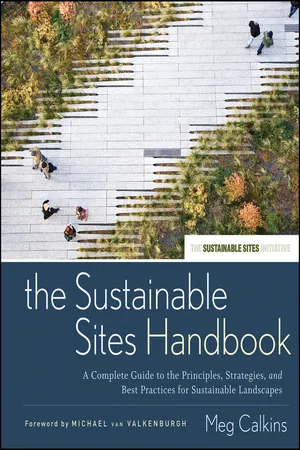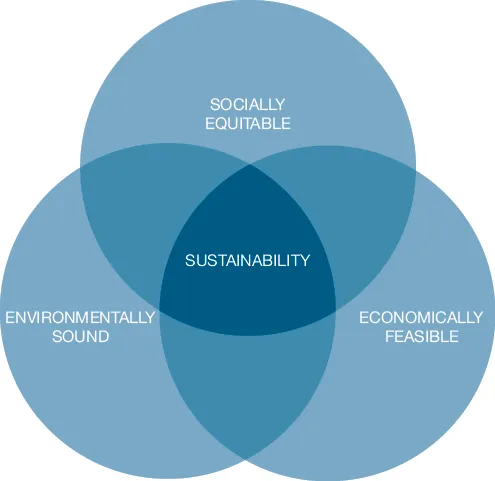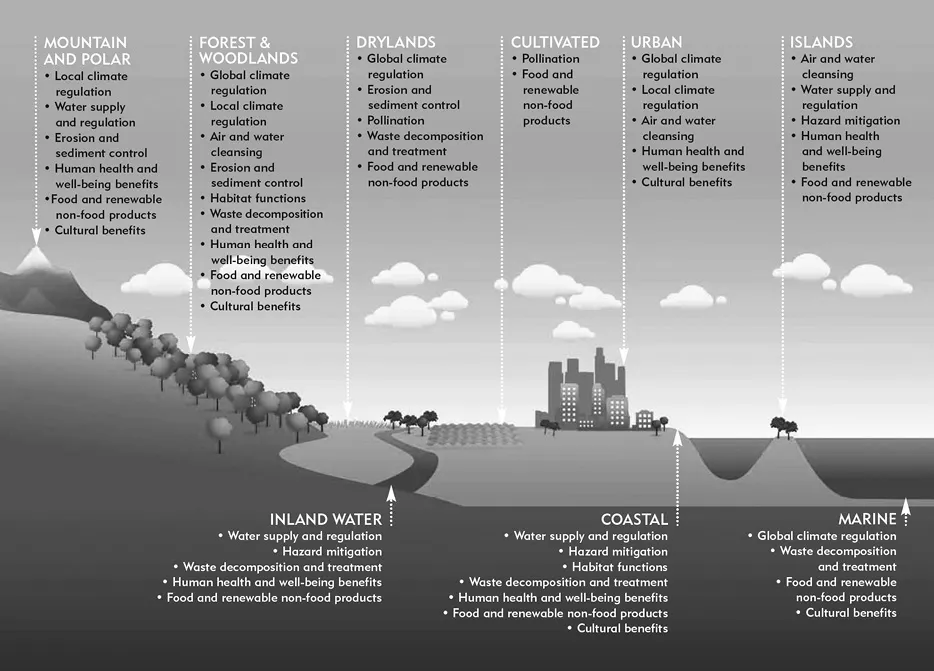![]()
Chapter 1
Introduction
Meg Calkins
The natural environment is comprised of complex, interrelated systems of water, soil, air, atmosphere, flora, and fauna that are constantly evolving, balancing, changing, and rebalancing. These ecosystems offer services such as air and water cleansing, water supply and regulation, and productive soil that sustain and enhance human systems—services that are critical to survival of all species. Designed sites can protect, sustain, and even provide these critical ecosystem services. Offering potential to serve multiple functions, sites can be productive, provide ecosystem services, and offer rich aesthetic experiences to the site occupants.
This idea of ecosystem services as a basis for design is a profound shift in the way that we think about the role of designed sites. If we are to design and manage sites that support and engage natural processes, we need to shift our focus from creating and maintaining static, isolated landscapes to that of designing and managing complex, interrelated living systems of the built environment. And as a model for designing site systems that can ensure sustainable development, we need look no further than the principles inherent in our planet’s ecosystems, principles that include zero waste, adaptation, and resiliency.
If we are to protect the world’s ecosystems for future generations, the human-made environment must foster the health of both ecological and human systems. Design of the built environment, including site design, plays a critical role in this. In 2000, the United Nations commissioned the Millennium Ecosystem Assessment, a global study by 1,360 scientists from an international consortium of governments, universities, nonprofits, and businesses. The 2005 concluding report stated that “human activity is having a significant and escalating impact on the biodiversity of world ecosystems, reducing both their resilience and biocapacity” (MEA 2005). The report, referring to natural systems as humanity’s “life support system,” established that “ecosystems are critical to human well-being—to our health, our prosperity, our security, and to our social and cultural identity” and unless we change the way that we develop land, use resources, and produce food, these services will be seriously compromised for future generations. The report warns: “At the heart of this assessment is a stark warning. Human activity is putting such a strain on the natural functions of Earth that the ability of the planet’s ecosystems to sustain future generations can no longer be taken for granted” (MEA 2005).
In response to this imperative, the Sustainable Sites Initiative™ (SITES™), a partnership of the American Society of Landscape Architects, the Lady Bird Johnson Wildflower Center at the University of Texas at Austin, and the United States Botanic Garden, have released Guidelines and Performance Benchmarks to guide development of sustainable sites through a voluntary credit rating system. These guidelines and benchmarks encourage the protection, restoration, and provision of ecosystem services as a basis for sustainable site design. They address the design and management of systems of vegetation, soils, water, materials, energy, and culture.
This book has been created to offer comprehensive and detailed information on strategies, technologies, tools, and best practices for sustainable site design. This book, like the SITES Guidelines and Performance Benchmarks, is based on the premise that any site in any location can be designed and managed to foster healthy ecosystems, and promote ecosystem services and sustainable human systems. It is intended to assist practitioners with successful implementation of the SITES rating tool, and it will also stand as a resource guide for the design and management of sustainable sites. This publication, developed with the cooperation of the Sustainable Sites Initiative, will complement the Guidelines and Performance Benchmarks, the prerequisites and credits, and future SITES publications. It will be a companion resource that practitioners can turn to for deeper guidance on the topics of hydrology, vegetation, soils, materials, human health and well-being, and site selection.
Sustainable SITE Design Defined
Sustainable design as defined by SITES is “design, construction, operations and maintenance practices that meet the needs of the present without compromising the ability of future generations to meet their own needs” (SITES 2009a). This is based on the definition of sustainable development from the United Nations World Commission on Environment and Development’s Bruntland Report, Our Common Future (UNWCED, 1987). For site design, this translates to fostering both human and natural ecosystem health, closing material and resource loops, and designing with respect for nutrient and water cycles. Sustainable site design emphasizes design of whole, complex functioning systems; a widened scale of analysis and design consideration; highly site-specific (as opposed to universal) design responses; and continued monitoring, management, and adaption to ensure healthy, functioning systems for the life of the landscape.
Design of sustainable sites involves a fundamental shift in the way that we think about the Earth and its resources. We must shift from the extractive mind-set of viewing the Earth’s resources as abundantly available for human consumption to the understanding that Earth’s resources and ecosystems are the sustainers of life on this planet and must be protected. New development must work toward fostering the health of ecosystems and the services they provide through their protection and restoration. We must forge a new and respectful relationship with natural systems, acknowledging their critical role in our health and the health of the planet.
Triple Bottom Line
Sustainability encompasses not only environmental conservation, but also the ideals of social equity and economic feasibility. This “triple bottom line” is the key to truly sustainable development (Figure 1-1). While this book primarily focuses on environmental sustainability, it addresses areas of social and economic sustainability as they relate to environmental issues and sustainable site design. Design of the built environment also has a direct impact on human and cultural systems. Therefore, a chapter is devoted to human health and well-being considerations of site development.
Ecosystem Services
Ecosystem services are defined in the Millennium Ecosystem Assessment as “the benefits humans obtain from ecosystems” (MEA 2007). Living elements of ecosystems, such as vegetation and soil organisms, interact with the nonliving elements such as water, air, and bedrock in ecosystem processes to produce goods and services that offer direct or indirect benefits to humans. The MEA groups ecosystem services into four broad categories (MEA 2005):
- Provisioning, such as the production of water, clean air, food, and medicines;
- Supporting, such as pollination, waste decomposition, and nutrient cycling;
- Regulating, such as global and local climate regulation, erosion control, disease control; and
- Cultural, such as health, spiritual, recreation, and relaxation benefits.
There are many ecosystem services that can be provided by sites (Figure 1-2) (Table 1-1). Some examples are:
- Trees regulate local climate through evapotranspiration, shade, and wind control.
- Vegetation mitigates local air quality.
- Soils and vegetation infiltrate and purify stormwater protecting adjacent waterways and the water table.
- Vegetation and construction materials mitigate heat island impacts in urban areas.
- Vegetation, water, and materials are combined to make parks, gardens, and open spaces for human health and well-being and cultural benefits.
- Water and soil organisms break down waste and cycle nutrients.
It is important to note that site development decisions can impact ecosystem services far away from a site as well—and these impacts are not often easily seen or understood. Decisions about stormwater management and vegetation inputs (e.g., fertilizers and herbicides) can impact waterways hundreds of miles downstream. Resource extraction and material manufacturing can impact ecosystems halfway around the world. And air currents can carry airborne pollutants far away from the manufacturing plant that released them.
Table 1-1: Ecosystem Services
| Global climate regulation | Maintaining balance of atmospheric gases at historic levels, creating breathable air, and sequestering greenhouse gases |
| Local climate regulation | Regulating local temperature, precipitation, and humidity through shading, evapotranspiration, and windbreaks |
| Air and water cleansing | Removing and reducing pollutants in air and water |
| Water supply and regulation | Storing and providing water within watersheds and aquifers |
| Erosion and sediment control | Retaining soil within an ecos... |


